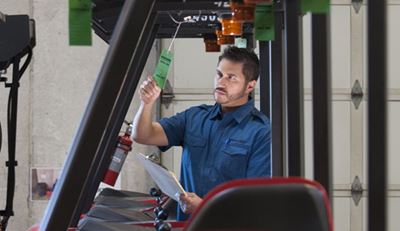Are you set up for seasonal success?

Seasonality affects nearly every type of business. These peak seasons can be challenging to keep up with. When is your plant’s busy season? When it hits, do you feel prepared? Here are six tips to consider as you ramp up for seasonal success.
Seasonality affects nearly every type of business. Late summer and fall are met with the rush of Halloween costumes and decorations, and then comes the influx of holiday toys. Home improvement projects are popular in the spring. These peak seasons can be challenging to keep up with.
When is your plant’s busy season? When it hits, do you feel prepared? Here are six tips to consider as you ramp up for seasonal success.
Make short-term decisions
Short-term equipment rentals can be one of the easiest and most effective ways to prepare for a seasonal peak — and a great way to have the right equipment available for the expected increase in business. Having the right forklift provider with quality equipment is key to handling the heightened amount of product moving through the warehouse. Make sure you’ve selected a good partner that can get you what you need and provide necessary support so you can minimize costs and maximize uptime.
Use a third-party logistics provider
An experienced third-party logistics provider (3PL) can offer much more than storage opportunities. A key benefit that many 3PLs can offer is management of staff and in-house supply chain operations, allowing your time to be reallocated to other plant responsibilities. A 3PL can also assist with transportation, distribution, and packaging options during your busy season—making it easier to scale as needed to meet demand.
Invest in automation
Holiday fulfillment for wholesale orders will increase and peak significantly earlier than e-commerce orders. Automation can fulfill repetitive tasks to streamline operations and free up your employees’ time for more value-added tasks. For example, robots for palletizing outgoing shipments can help to optimize the warehouse, and automatic sealing and taping machines can decrease the number of seasonal employees required.
Plan for seasonal hiring and training
With a low unemployment rate, it can be challenging to find skilled employees, especially as other employers ramp up their seasonal hiring efforts. Make your company stand out and attract younger talent with virtual reality education. Many manufacturers are collaborating with technology companies to design virtual-reality simulators to assist with teaching new forklift operators more efficiently and effectively.
Virtual-reality simulators can also be used to quickly screen seasonal applicants and see whether they will be a good fit to operate forklifts. Providing the opportunity to learn with an innovative workplace tool and recognizing a company’s commitment to technology and workforce advancement can also increase the likelihood that employees will stay with your company after peak season is over.
Embrace the idea of cross-docking
Cross-docking reduces labor costs, the need for additional warehouse space for storage, and delivery time to customers. In some cases, cross-docking can be implemented for specific orders so you can expedite shipments to customers with less material handling required—the goal of an optimized supply chain. Successful cross-docking requires carefully planned inventory processes and trained staffers to implement, but it can be used after the seasonal peaks for year-round success.
Keep a finger on the pulse of trends and leverage your data
Track trends and be mindful of how they could affect the industry and your company. Examine what happened last year, as this may reveal patterns or insights that can help you plan for next year’s season.
Did a new product rollout require additional manpower, equipment or logistics? Will this same scenario happen again next year? How will it change delivery timelines and work flow? These questions are important to ask so you can be ready for the next big trend.
Some parts of the year are busier than others. That’s why it’s critical to prepare now, so that when the craziness hits, your plant will be prepared. The tips can help you determine the best course of action for your operations currently, and in the future, so your next peak season will be a successful one.
Submitted by Jonathan White, Abel Womack, an authorized Raymond Solutions and Support Center
Plant Services, Today's Optimized Facility

